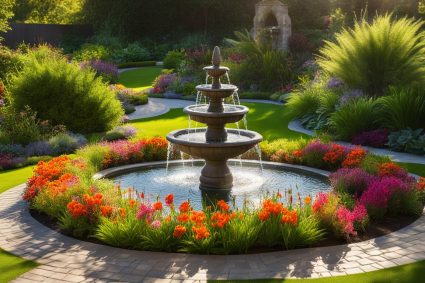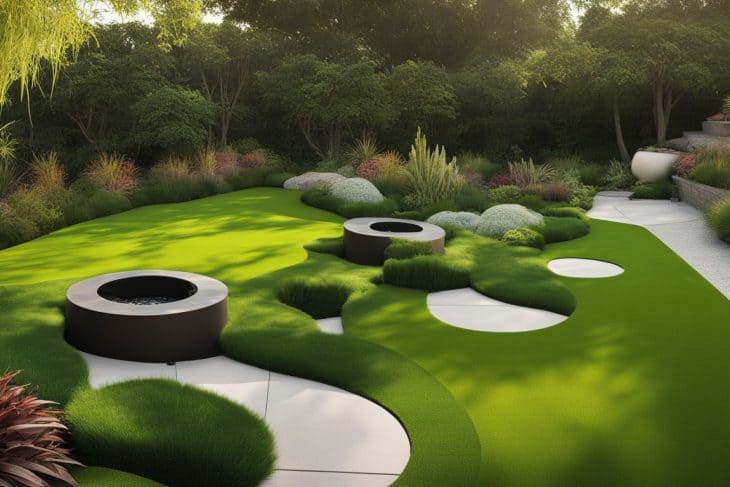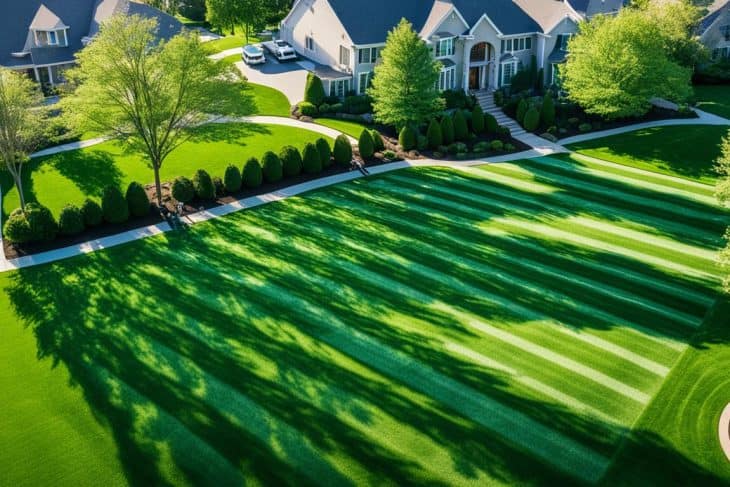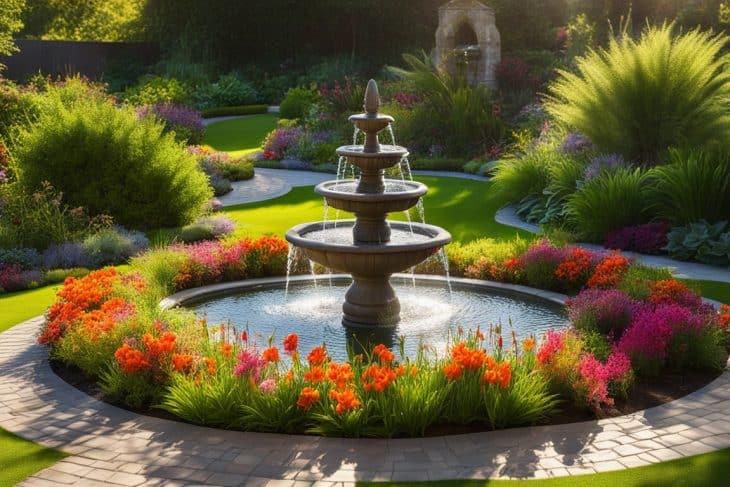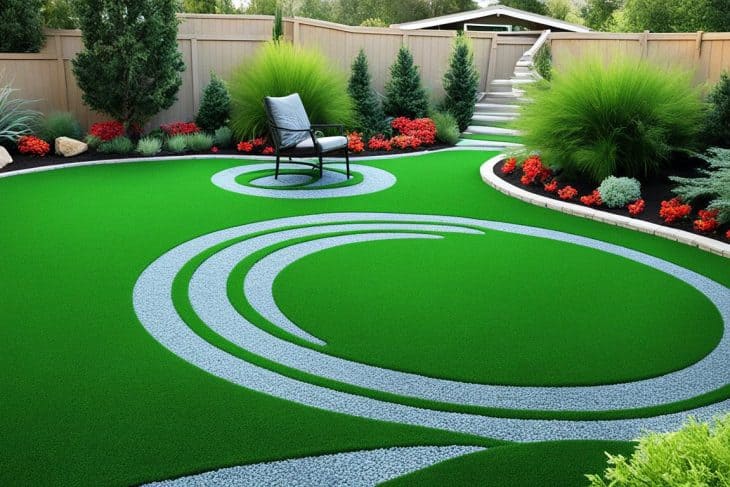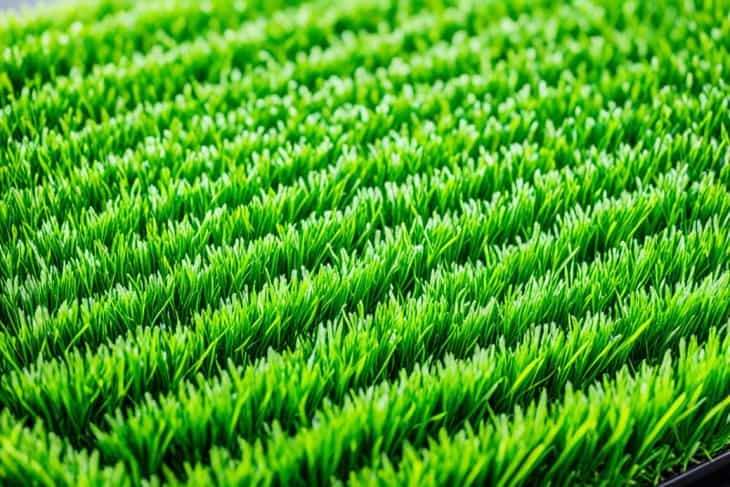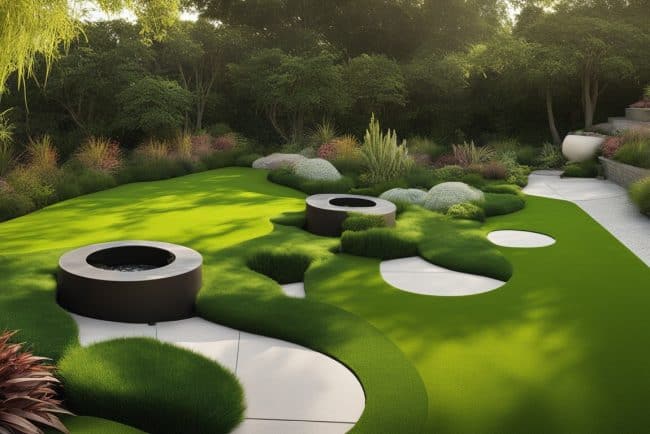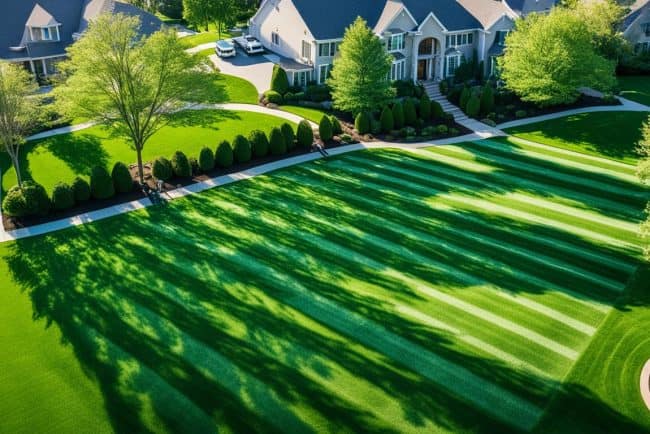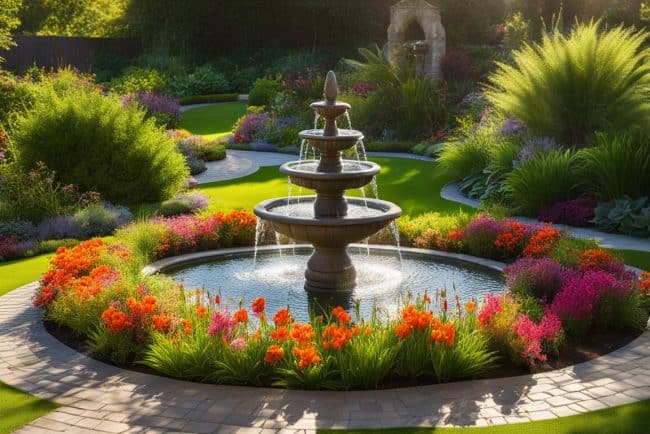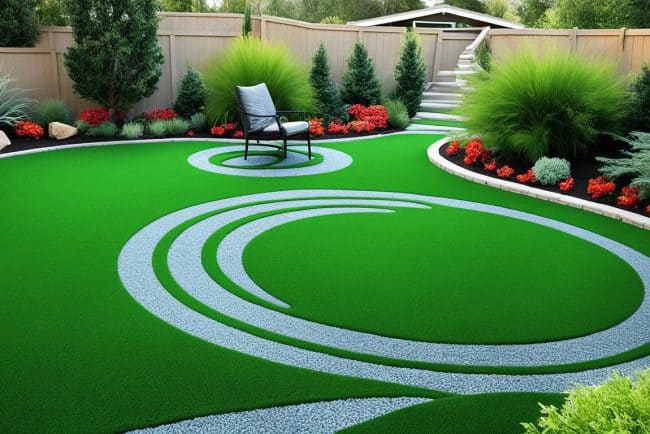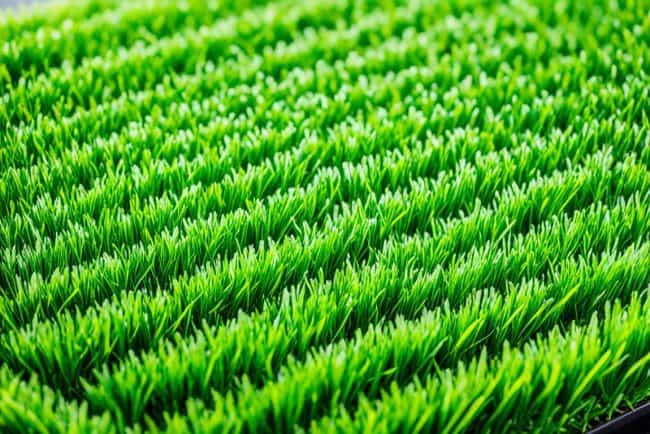
The synthetic turf industry in North America was valued at about $2.7 billion USD in 2020. This shows a growing trend in eco-friendly artificial turf among homeowners and businesses. They’re looking for sustainable lawn care alternatives that save water and look great.
Companies like SYNLawn® are at the forefront with eco-friendly artificial turf. They use non-toxic, plant-based materials to mimic natural grass. This innovative approach reduces environmental impact while offering a viable landscaping choice. Discover how Green Grass Solutions can change your outdoor areas into beautiful, sustainable spaces.
What is Eco-Friendly Artificial Grass?
Eco-friendly artificial grass is a popular choice for those who love the planet. This type of synthetic grass looks and feels like real grass. It’s great for the looks of your lawn while being good for the environment. Instead of using materials that harm the earth, it uses plant-based stuff like soybean oil and sugarcane.
The way eco-friendly artificial grass is made helps the planet. It uses renewable resources which supports sustainable farming. Farmers benefit by growing the materials needed for this grass. Also, using recyclable parts means your lawn isn’t hurting the earth. It’s a win-win for you and nature.
Eco-friendly artificial grass can also save you money in the long run. Yes, it might cost more at first compared to regular grass. But it can last up to 25 years! You won’t have to replace it often, and it needs less care. Plus, you could save up to 22,000 gallons of water every year. That’s a big help in saving water.
This type of grass doesn’t just look good. It’s also better for our planet. By choosing it, you avoid using dangerous chemicals and fertilizers. So, your outdoor space is safer for your family and pets. It’s a smart choice for a greener and healthier lawn.
Benefits of Eco-Friendly Artificial Grass
Eco-friendly artificial grass offers big pluses for both the planet and your wallet. Homeowners love not just how it looks but the practical upsides too. Saving water and money, plus needing less care while lasting a long time, are top benefits of this green turf.
Water Conservation and Cost Savings
Eco-friendly artificial grass helps a lot in saving water. Normal lawns use a ton of water, which costs big bucks. By picking eco-friendly turf, I can save up to 55 gallons of water for each square foot every year. This makes a huge difference in water conservation over the whole property. It’s especially important in places running low on water.
On top of saving water, not needing sprinkler systems saves money over the years. Homeowners see smaller bills and help the environment too. Not having to use bad chemicals like pesticides adds to the savings. Living this way is better for the earth.
Low Maintenance and Durability
Want a beautiful yard without much work? Eco-friendly artificial grass is the answer. No mowing or watering means more time to relax. It stays nice all year round, minus the hard work real grass needs.
This tough turf can look great for up to 25 years, saving money on replacements. It’s made to handle lots of use and doesn’t attract bugs or cause allergies. This makes the outdoors safer and more fun for both people and pets. Choosing durable turf means fewer replacements, which is better for the planet.
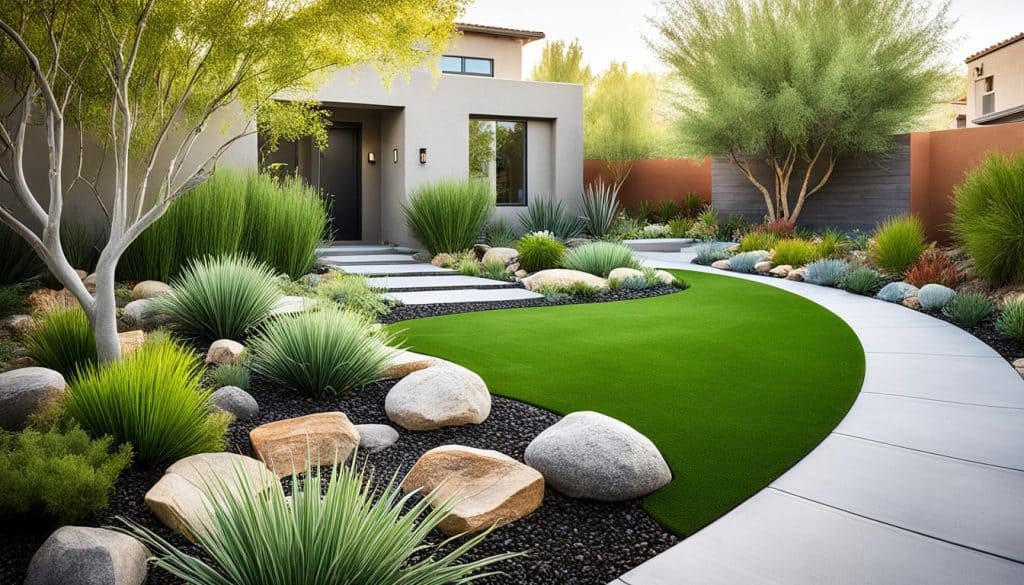
| Benefit | Impact |
|---|---|
| Water Conservation | Save up to 55 gallons per square foot annually |
| Cost Savings | Lower utility bills due to reduced water usage |
| Low Maintenance | No mowing or watering needed |
| Durability | Lasts up to 25 years, reducing replacement costs |
| Healthier Environment | No need for harmful chemicals like pesticides |
Environmental Impact of Eco-Friendly Turf
Eco-friendly turf offers both pros and cons for the environment. It stands out as a top pick in sustainable landscapes, thanks to its ability to eliminate the need for gas mowers. This cuts down on pollutants and reduces the carbon footprint from lawn care.
Such turf is made from materials like polyethylene, often using recycled content. This reduces dependency on petroleum and decreases waste. The long life of artificial turf, lasting 10 to 20 years, also helps lower its environmental impact over time.
However, installing artificial grass can have downsides. It often means removing natural grass and soil, which hampers rainwater from soaking into the earth. This can dry out the soil and increase runoff, leading to possible flooding.
Another issue is microplastic pollution from some artificial turfs. These can break down and release tiny harmful particles. But, not having to use fertilizers and pesticides, like with real lawns, is better for the environment. It’s important to think about these points to make the best landscaping choices.

| Aspect | Eco-Friendly Turf | Natural Grass |
|---|---|---|
| Water Usage | Requires little to no watering | Can consume up to 10,000 gallons annually |
| Maintenance | No mowing needed, less reliance on chemicals | Requires regular mowing and chemical treatments |
| Lifespan | 10-20 years with light maintenance | Requires regular replacement |
| Carbon Footprint | Reduced emissions from lawn care equipment | Emissions from gas-powered mowers |
| Soil Health | Preserves topsoil, preventing erosion | Can contribute to soil erosion |
Green Grass Solutions: Installation Process
Starting with the right preparation is key to installing eco-friendly turf. We clean the area of any plants, debris, and rocks. This makes for a smooth base. Adding a barrier against weeds stops plants from growing through later. Good drainage will also make the turf last longer. This prep work is crucial.
Preparing the Installation Site
I start by checking the turf area. This usually means taking out old sod to even out the ground. A geotextile membrane boosts drainage. Choosing to add a weed barrier is important. These steps help clean and prep the surface for the artificial grass.
Laying and Securing the Turf
After prepping the site, I lay down the turf. Aligning it right and trimming around edges is crucial. I secure the turf with landscape staples to keep it flat, avoiding lumps. Adding infill materials gives it stability and softness, keeping it good as new with foot traffic.
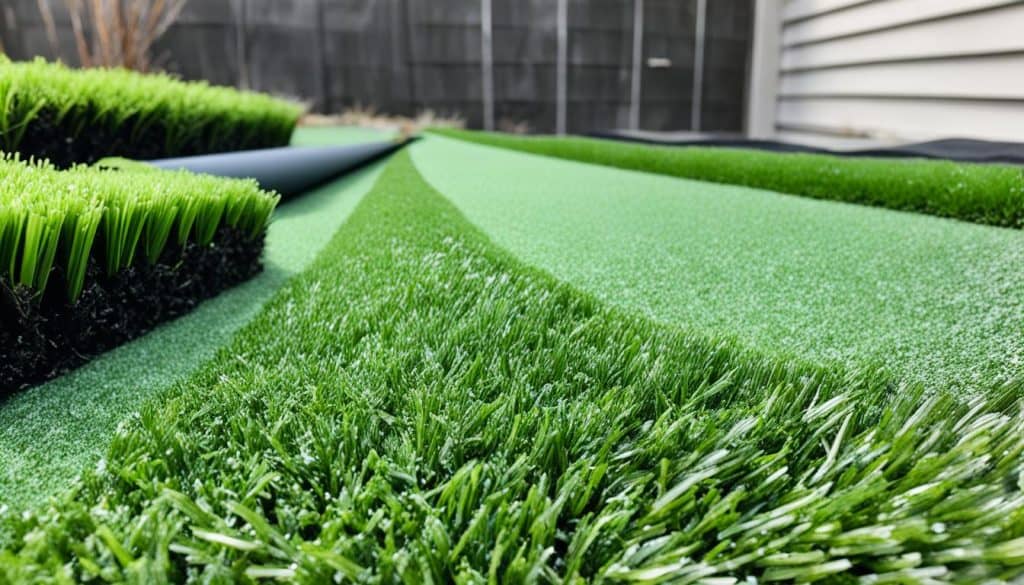
Maintenance Tips for Eco-Friendly Artificial Grass
It’s easy and crucial to maintain eco-friendly artificial grass to make it last longer. With the right care, synthetic turf can remain good for 15 to 25 years. Keeping it clean and free from debris helps a lot.
For good turf care, regularly take away dirt and debris. This stops the grass from matting and bacteria from growing. Use a broom or rake to keep the fibers upright, making the turf look nice. Rinse it with a hose every week to remove dust and keep its color bright. Pay more attention to busy spots by brushing them in different directions to keep them looking great.
When spills happen, clean them up fast. Use safe cleaners like white vinegar or enzyme cleaners to keep the surface safe and clean. It’s also critical to remove pet waste right away to avoid smells and bacteria.
To stop weeds and moss, treat your turf twice yearly, especially in shaded areas. Ask experts for advice tailored to your lawn’s needs. Doing this not only keeps your lawn looking good but also makes it last longer. This creates a lovely outdoor space for many years.
Follow these eco-friendly tips for upkeeping your artificial grass, and you’ll have a low-maintenance, beautiful outdoor area. This approach saves effort and gives great results.
| Maintenance Task | Frequency | Benefits |
|---|---|---|
| Debris Removal | Weekly | Prevents matting and bacterial growth |
| Rinsing | Weekly | Removes dust and small debris |
| Weed and Moss Treatment | Twice a year | Prevents unwanted growth |
| Spill Cleanup | As needed | Prevents permanent stains |
Choosing the Right Eco-Friendly Turf Option
When choosing artificial grass, it’s crucial to assess texture, color, and how you’ll use it. This approach helps me find the perfect match for my yard. With many eco-friendly options out there, I can tailor my choice. This makes my outdoor space look great and supports green living.
It’s important to look for eco-certifications, like those from the USDA. These show the turf is made with care for the planet. I prefer turf from companies like ProGreen. Their products are 100% recyclable, reducing waste by being repurposed.
Choosing durable, eco-friendly turf pays off in the long run. It not only saves water but also cuts down on the use of gas mowers. For me, investing in quality turf means my yard looks good and I’m doing my part for the earth.
